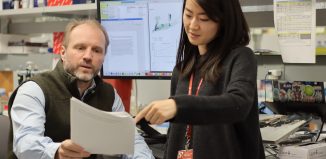BNL’s Tranquada studies magnetic strips in superconductors
John Tranquada, the great grandson of a Portuguese stowaway on a ship to Honolulu, was in junior high school in California when the Beatles’ “Abbey Road” came out. The iconic cover image, with John Lennon, Ringo Starr, Paul McCartney and George Harrison, walking over a crosswalk stayed with him over four decades later.
In recent months, when a group of scientists at Brookhaven National Laboratory were preparing to announce the results of their latest finding, Tranquada suggested that the image of the four Beatles walking across that striped crosswalk all those years ago and thousands of miles from the original location might be worth copying. Their recent experiments, after all, detected through an indirect method the fluctuating stripes in a model compound designed to study superconducting materials.
They readily agreed and the stage was set to borrow an iconic musical image to illustrate their research.
Superconductivity holds promise for future technology and innovation because superconductors allow the transfer of energy without any resistance. The cost of manufacturing superconducting cable has been prohibitive.
Tranquada has been studying the magnetic stripes in superconductors for over 18 years.
The electrons, or negatively charged particles, tend to spread out uniformly in space in a superconductor. An analogy, Tranquada offered, is water in a flat bottomed pan. It will spread out to uniform depth. If the water formed a ripple pattern that stayed in the same place, “We would be shocked,” he said. This, however, is just the sort of thing that happens to the electrons in certain superconducting materials.
While copper-oxides are superconductors, the scientists replaced the copper with nickel to create a model compound that could be easier to study. Tranquada knew from previous work that stripes form in nickel-oxide when cooled.
In recent research, he warmed up a nickel-oxide compound, causing the ordered stripes to disappear. The measurements of the team, however, indicated that the stripes still had to be present. Since they knew the stripes weren’t present in a static fashion, they inferred the stripes had to be fluctuating dynamically — or moving.
“This model system teaches us what diffraction-scattering signature to look for in copper-based semiconductors to see if these fluctuations exist,” Emil Bozin, a co-author on the study and member of the X-Ray Scattering Group at BNL, said in a statement.
That search, the researchers suggested, should lead to a better understanding of the role of stripes in superconductivity and, down the road, to new approaches to create superconductors in the energy arena.
Tranquada said his role in the band of scientists was to provide a history and understanding of the materials. “I’ve been studying these nickel oxides for 20 years,” he said.
Tranquada’s colleagues at BNL praised his contribution to the department. He is “a great colleague to have around,” said Peter Johnson, the chair of BNL’s Condensed Matter Physics & Materials Science Department. “He has a really deep and wide-ranging understanding of the field of superconductivity. He’s the guy I go to when I want to get insight into newly published results.”
Tranquada’s discoveries have “provided inspiration to the larger community for more than two decades,” Johnson said. Tranquada said scientists are looking for a convincing explanation for what makes materials superconducting.
Tranquada is excited to be a part of a team that is providing evidence that these stripes can coexist with superconductors. The experiments on superconductors “often reveal behavior that theorists have not anticipated, so it’s like exploring an unknown world,” he said.
Tranquada lives in Stony Brook with his wife Lisa, who is retired after a career that included working at the Pacific Science Center in Seattle and doing administrative work at BNL for 20 years. Their daughter Jessica, 23, graduated from Cornell last year and is revitalizing a riding stable as a “one-person design and construction team,” Tranquada said.
Their son Matthew, 27, is in Washington, D.C., where he has cleared the first few hurdles in the process of applying for a job in the State Department.
Tranquada enjoys jogging in the area and sea kayaking. His family bought a couple of kayaks last summer.
As for the picture of the stripes from Abbey Road, Tranquada said he proposed the idea initially almost as a joke, but his collaborators, which include lead author and BNL X-Ray Scattering Group member Milinda Abeykoon, liked it. They even asked the facilities and operations staff to park a red cart where the Volkswagen car was in the original album.
In the 1970s, Tranquada said he knew he wanted to be a scientist and, for about “two seconds” thought about becoming an astronaut, but realized that probably wouldn’t fly because he gets “sick on the tea cup ride in Disneyland.”






